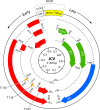Molecular biology, epidemiology, and pathogenesis of progressive multifocal leukoencephalopathy, the JC virus-induced demyelinating disease of the human brain
- PMID: 22763635
- PMCID: PMC3416490
- DOI: 10.1128/CMR.05031-11
Molecular biology, epidemiology, and pathogenesis of progressive multifocal leukoencephalopathy, the JC virus-induced demyelinating disease of the human brain
Abstract
Progressive multifocal leukoencephalopathy (PML) is a debilitating and frequently fatal central nervous system (CNS) demyelinating disease caused by JC virus (JCV), for which there is currently no effective treatment. Lytic infection of oligodendrocytes in the brain leads to their eventual destruction and progressive demyelination, resulting in multiple foci of lesions in the white matter of the brain. Before the mid-1980s, PML was a relatively rare disease, reported to occur primarily in those with underlying neoplastic conditions affecting immune function and, more rarely, in allograft recipients receiving immunosuppressive drugs. However, with the onset of the AIDS pandemic, the incidence of PML has increased dramatically. Approximately 3 to 5% of HIV-infected individuals will develop PML, which is classified as an AIDS-defining illness. In addition, the recent advent of humanized monoclonal antibody therapy for the treatment of autoimmune inflammatory diseases such as multiple sclerosis (MS) and Crohn's disease has also led to an increased risk of PML as a side effect of immunotherapy. Thus, the study of JCV and the elucidation of the underlying causes of PML are important and active areas of research that may lead to new insights into immune function and host antiviral defense, as well as to potential new therapies.
Figures











References
-
- Agostini HT, et al. 1995. BK virus and a new type of JC virus excreted by HIV-1 positive patients in rural Tanzania. Arch. Virol. 140:1919–1934 - PubMed
-
- Agostini HT, et al. 2000. Influence of JC virus coding region genotype on risk of multiple sclerosis and progressive multifocal leukoencephalopathy. J. Neurovirol. 6 (Suppl. 2): S101–S108 - PubMed
-
- Agostini HT, Ryschkewitsch CF, Brubaker GR, Shao J, Stoner GI. 1997. Five complete genomes of JC virus type 3 from Africans and African Americans. Arch. Virol. 142:637–655 - PubMed
-
- Ahmed W, Wan C, Goonetilleke A, Gardner T. 2010. Evaluating sewage-associated JCV and BKV polyomaviruses for sourcing human fecal pollution in a coastal river in Southeast Queensland, Australia. J. Environ. Qual. 39:1743–1750 - PubMed
Publication types
MeSH terms
Substances
Grants and funding
- R01NS043097/NS/NINDS NIH HHS/United States
- R01NS35000/NS/NINDS NIH HHS/United States
- F32NS070687/NS/NINDS NIH HHS/United States
- R01 NS043097/NS/NINDS NIH HHS/United States
- F32 NS070687/NS/NINDS NIH HHS/United States
- ImNIH/Intramural NIH HHS/United States
- R01 NS035000/NS/NINDS NIH HHS/United States
- R01MH086358/MH/NIMH NIH HHS/United States
- R01 CA071878/CA/NCI NIH HHS/United States
- P01NS065719/NS/NINDS NIH HHS/United States
- R01 MH086358/MH/NIMH NIH HHS/United States
- P01 NS065719/NS/NINDS NIH HHS/United States
- R01CA071878/CA/NCI NIH HHS/United States
LinkOut - more resources
Full Text Sources
Other Literature Sources

